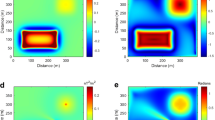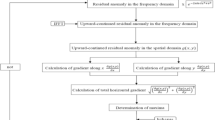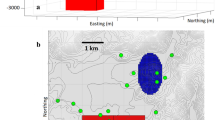Abstract
CURVGRAV-GUI is an open source software that was developed to interpret gridded gravity data by using curvature technique. It was developed using C# language with Microsoft.NET Framework 4.0. This program calculates the critical and extreme points, and estimates the depths of source bodies at this points. Besides, CURVGRAV-GUI processes gravity data by using minimum curvature, one of the attributes of curvature, and detects the subsurface lineaments. It is a user-friendly application that can display obtained solutions and gravity data thanks to image and scatter maps. CURVGRAV-GUI was designed to develop both synthetic and field applications. Additionally, the β constant, a parameter related to the source geometry, was examined for different source types such as sphere, horizontal and vertical cylinder and thin vertical fault. This program was tested by using two synthetic model applications. In the first synthetic model application, it was used a complex synthetic model consisting of three sphere and a horizontal cylinder located at the different depths. In the second synthetic model application, a graben model consisting of two thin vertical fault was used. Finally, the performance of the CURVGRAV-GUI was tested with using a real gravity data belonging to Kozakli-Central Anatolia region, Turkey. Very successful results were obtained for both synthetic and field data. Earth scientist can use CURVGRAV-GUI for educational experiments.












Similar content being viewed by others
References
Barraud J (2013) Improving identification of valid depth estimates from gravity gradient data using curvature and geometry analysis. First Break 31:87–92
Cordell L (1979) Gravimetric expression of graben faulting in Santa Fe country and the espanola basin, New Mexico. New Mexico Geol Soc Guidebook, 30th Field Conference, pp 59–64
Ekingen A (1971) Gravimetric method in geothermal field explorations and its application in Turkey. First geothermal energy symposium of Turkey, Ankara, pp 60–74
Grauch VSJ, Cordell L (1987) Limitations of determining density or magnetic boundaries from horizontal gradient of gravity or pseudogravity data. Geophysics 52(1):118–121
Hansen RO, DeRidder E (2006) Linear feature analysis for aeromagnetic data. Geophysics 71(6):L61–L67
Miller HG, Singh V (1994) Potential field tilt-a new concept for location of potential field sources. J Appl Geophys 32:213–217
Nettleton LL (1976) Gravity and magnetics in oil exploration. Mac Graw-Hill, New York
Oruç B (2011) Edge detection and depth estimation using a tilt angle map from gravity gradient data of the Kozaklı-central Anatolia region, Turkey. Pure Appl Geophys 168:1769–1780
Peet FG, Sahota TS (1985) Surface curvature as a measure of image texture. IEEE Transaction on Pattern Analysis and Machine Intelligence PAMI-7(6):734–738
Phillips JD, Hansen RO, Blakely RJ (2007) The use of curvature in potential-field interpretation. Explor Geophys 38:111–119
Reid AB, Allsop JM, Granser H, Millett AJ, Somerton IW (1990) Magnetic interpretation in three dimensions using Euler deconvolution. Geophysics 55:80–91
Roberts A (2001) Curvature attributes and their application to 3D interpret horizons. First Break 19(2):85–100
Salem A, Ravat D, Smith S, Ushijima K (2005) Interpretation of magnetic data using an enhanced local wave number (EWL) method. Geophysics 70:L7–L12
Sertcelik I, Kafadar O (2012) Application of edge detection to potential field data using eigenvalue analysis of structure tensor. J Appl Geophys 84:86–94
Smith RS, Thurston JB, Dai TF, MacLeod IN (1998) iSPI-the improved source parameter imaging method. Geophys Prospect 46:141–151
Thomas GB (1972) Calculus and analytical geometry, fourth edition. Addison-Wesley Publishing Company, Reading, USA, pp 473–475
Thompson DT (1982) EULDPH-a new technique for making computer assisted depth estimates from magnetic data. Geophysics 47:31–37
Thurston JB, Smith RS (1997) Automatic conversion of magnetic data to depth, dip, and susceptibility contrast using the SPI method. Geophysics 62:807–813
Verduzco B, Fairhead JD, Green CM, Mackenzie C (2004) The meter reader-new insights into magnetic derivatives for structural mapping. Lead Edge 23:116–119
Acknowledgements
I thank General Directorate of Mineral Research and Exploration for permission to use the gravity data of Kozakli-Central Anatolia region, Turkey. I also thank the referees for making valuable suggestions and comments in improving the manuscript.
Author information
Authors and Affiliations
Corresponding author
Additional information
Responsible Editor: H. A. Babaie
Appendix: Calculation of the β values for some source bodies
Appendix: Calculation of the β values for some source bodies
Sphere
Horizontal cylinder
Vertical cylinder
Vertical thin fault
The horizontal gradient of the vertical thin fault anomaly is equal to the horizontal cylinder anomaly. In this study, the curvature method was applied on horizontal gradient of vertical thin fault anomaly, therefore, the β parameter is 1.
Rights and permissions
About this article
Cite this article
Kafadar, O. CURVGRAV-GUI: a graphical user interface to interpret gravity data using curvature technique. Earth Sci Inform 10, 525–537 (2017). https://doi.org/10.1007/s12145-017-0306-6
Received:
Accepted:
Published:
Issue Date:
DOI: https://doi.org/10.1007/s12145-017-0306-6




